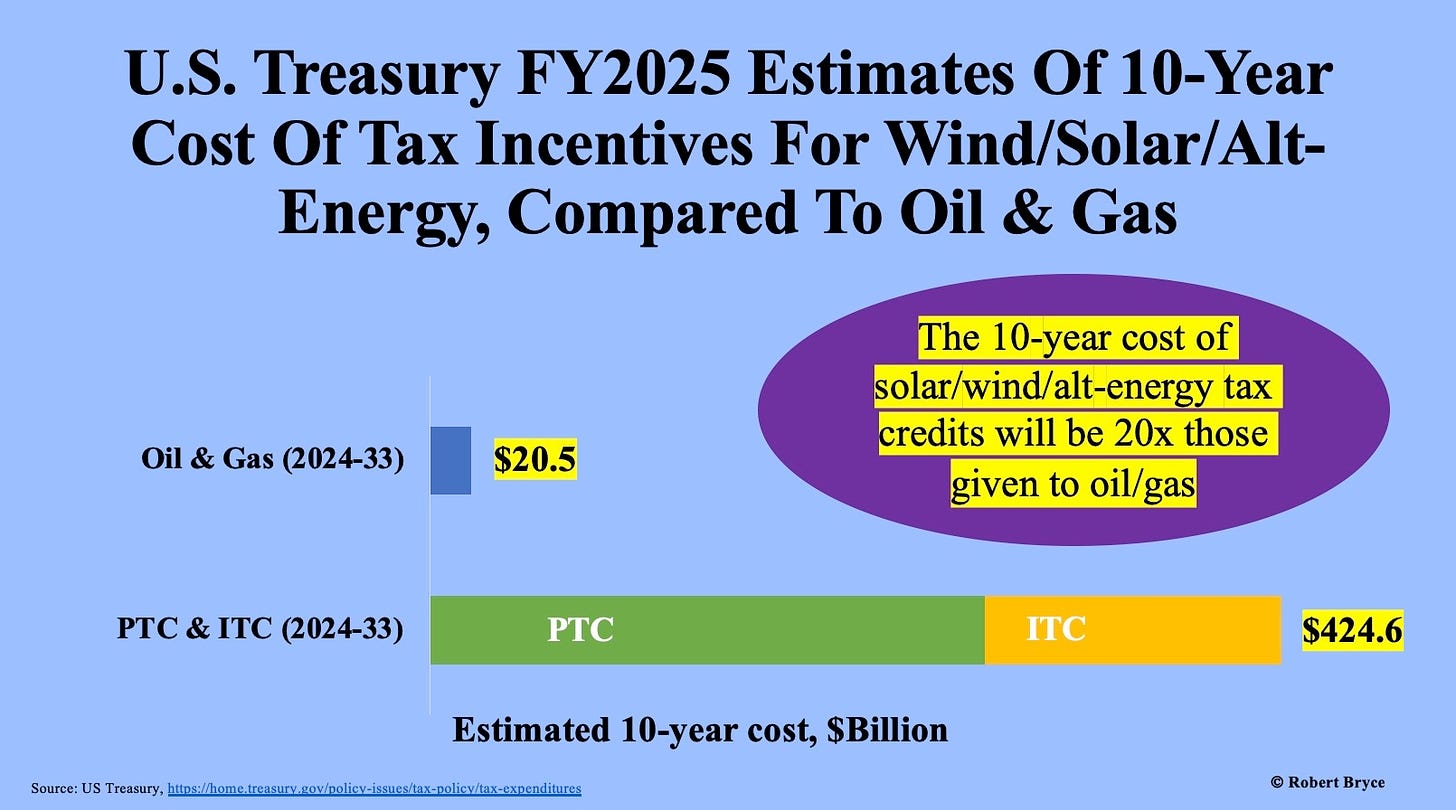By Robert Bryce, April 4, 2024
Last month, Senator Chuck Grassley, the 90-year-old Republican from Iowa, celebrated Sunshine Week by taking to the Senate floor with a speech about “the importance of whistleblowers in promoting transparency and accountability.” According to Whistleblower Network News, Grassley, who has frequently touted his efforts to fight waste, fraud, and abuse in government, declared that “to control a government as big as ours, it takes a lot of very bright light shining on every agency and office.”
A government as big as ours should be shining more light on alt-energy tax credits. Back in 2015, Grassley declared, “As the father of the first wind energy tax credit in 1992, I can say that the tax credit was never meant to be permanent.” Grassley made that statement while lauding a deal to phase out the production tax credit (PTC), the lucrative federal subsidy that has driven the wind industry’s growth for decades.
When he made that statement, the estimated 10-year cost to federal taxpayers of the PTC was $16 billion, and the investment tax credit (ITC), primarily used for solar energy, was about $3.9 billion.
Those were the good old days. The tax credits that were “never meant to be permanent” have not only become permanent, they have exploded in cost.

According to a March 11 report by the Office of Tax Analysis at the Treasury Department, the alt-energy sector will collect a staggering $424.6 billion over the next decade via the PTC and ITC. The agency estimates that between 2024 and 2033, the PTC will cost taxpayers $276.6 billion, and the ITC will cost $148 billion. The PTC and ITC are the most expensive energy-related preferences in the tax code. (The 10-year cost of tax credits for “clean vehicles” comes in third, at an estimated cost of $112 billion.)
Thus, since 2015, when Grassley (who has been in the U.S. Senate for 43 years) lauded the phaseout of the subsidies for wind energy, the tax credits for alt-energy haven’t decreased at all. Instead, they increased by a factor of 21!
This year alone, again, according to the Treasury, the PTC will cost taxpayers $7.5 billion, and the ITC will cost taxpayers $27.5 billion. Thus, alt-energy subsidies will cost the federal treasury $35 billion in 2024. For reference, the oil and gas industry’s biggest tax credit, the depletion allowance, will cost taxpayers about $1.6 billion. The total of all hydrocarbon tax credits this year will be about $2.1 billion.
Although the Office of Tax Analysis doesn’t explain why the cost of the ITC and PTC is skyrocketing, it’s clear evidence that the Inflation Reduction Act has become one of the biggest corporate giveaways in American history.
In just two years, the expected 10-year cost of PTC and ITC has nearly quadrupled. In its fiscal year 2023 report (the federal government’s fiscal year begins on October 1 and ends on September 30), the Treasury projected that the ITC and PTC together would cost taxpayers about $112.8 billion between 2022 and 2031.

So where is all this money going? The expansion of the PTC and ITC under the Inflation Reduction Act allows a panoply of non-hydrocarbon technologies to feast on federal tax credits. That includes a lucrative boost for existing nuclear plants. Under the revised PTC, owners of nuclear plants can collect up to $15 per megawatt-hour for the juice they generate. Over the next few years, the big money will be doled out through the ITC. Between now and 2027, the Treasury expects the ITC to cost taxpayers nearly $75 billion. Offshore wind projects will likely be among the biggest winners because the ITC provides a tax credit of up to 30% of the project’s cost. Offshore projects can get another 10% under the ITC if they use sufficient quantities of domestically produced iron and steel. Offshore wind is only part of the story. As the Treasury report explains, the ITC covers:
Solar and geothermal energy property, qualified fuel cell property, stationary micro-turbine property, geothermal heat pumps, waste energy recovery property, small wind property, offshore wind, energy storage technology, qualified biogas property, microgrid controllers, and combined heat and power property. The credit is 30 percent for projects that begin construction before 2020 and 26 percent for projects that begin construction in 2020-2022. The credit returns to 30 percent for projects that begin construction after 2022 but the full credit rate is dependent on meeting prevailing wage and apprenticeship requirements.
Recall that on August 16, 2022, when President Joe Biden signed the IRA, he said the measure “invests $369 billion to take the most aggressive action ever — ever, ever, ever — in confronting the climate crisis.”
Today, less than two years later, the Treasury is projecting that the cost of the IRA’s climate provisions will be nearly $425 billion over the next decade, or 15% more than what Biden claimed. Furthermore, the March 11 estimate from the Treasury likely understates the long-term cost of that legislation. In April 2023, Goldman Sachs estimated the IRA “will provide an estimated $1.2 trillion of incentives by 2032” for alt-energy incentives, including tax credits for electric vehicles.

As the Cato Institute’s Travis Fisher explained last September, the IRA is supposed to move to technology-neutral tax credits for low-carbon electricity production starting in 2025. Those tax credits will begin winding down by 2032 or when the power sector’s CO2 emissions are slashed by 75% compared to 2022 levels. (Note that the Department of Energy uses confusing phrasing for this requirement, saying the phaseout will only occur after emissions fall to 25% of 2022 levels.) But Fisher (who has an excellent Substack) points to a 2023 Energy Information Administration analysis, which found that even with a high uptake of IRA subsidies, emissions from the power sector are likely to decline by about 35% by 2050.
Indeed, the idea that the U.S. power sector will be able to slash its emissions by 75% — even by 2050 — is little more than wishful thinking. The energy consulting firm Wood Mackenzie has said the IRA tax credits could continue indefinitely. Fisher explained:
With an expanded time horizon, Wood Mackenzie found the cumulative cost of IRA energy credits could reach $2.5 to $3 trillion, most of which would go to utility‐scale solar energy projects. Of course, if EIA is right about the trajectory of GHG emissions from the electricity sector…the cumulative cost could be even higher. (Emphasis added.)
There’s plenty more to write about the massive subsidies going to alt-energy and how big business, big banks, big law firms, and climate-focused NGOs are profiting from this run on the federal treasury in the name of climate change. But less than two years after the passage of the IRA, it’s evident that the legislation will cost taxpayers trillions of dollars. Given that the national debt is now $34.6 trillion, and we are adding about $1 trillion more to that sum every three months, Senator Grassley should put a little sunshine on this alt-energy spending binge.
To subscribe to Robert Bryce’s Substack, go here.
Wind Concerns is a collaboration of citizens of the Lakeland Alberta region against proposed wind turbine projects.


